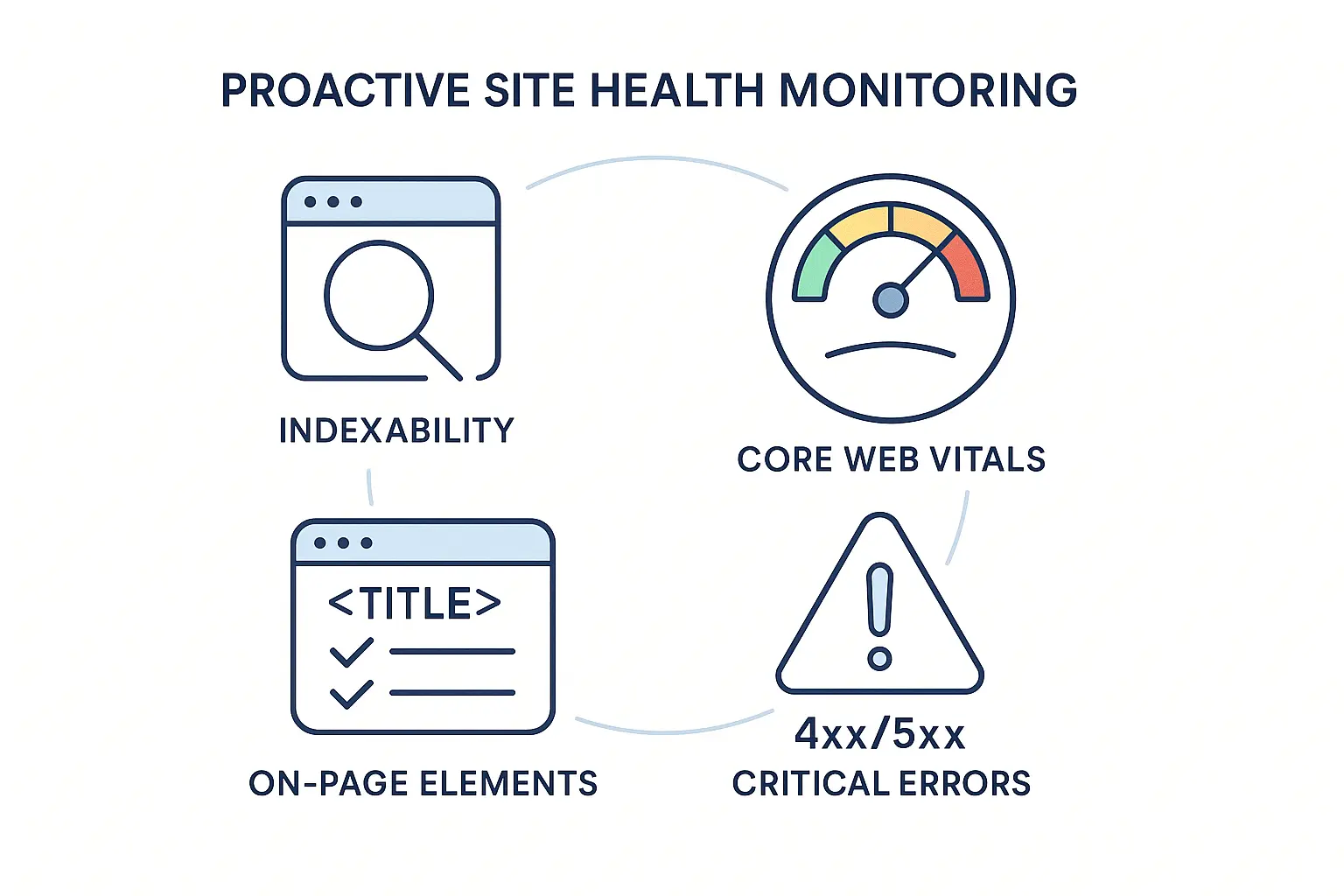It’s 9:03 AM on a Monday. You’re sipping your first coffee when an email lands in your inbox. The subject line: “URGENT: Traffic Drop?!”
Your heart sinks. A key client’s analytics show a nosedive over the weekend. You spend the rest of the day scrambling, digging through source code and server logs to find the culprit. It turns out a well-meaning developer accidentally added a ‘noindex’ tag to a key landing page during a Friday afternoon update, causing it to vanish from search results.
You fix it, of course. But the damage is done—not just to the client’s traffic, but to their trust in you. You were reactive, not proactive.
This scenario is all too common. Agencies report that up to 30% of their non-strategic time is spent on reactive ‘fire-fighting’ rather than proactive growth initiatives. This isn’t just inefficient; it’s a constant threat to client relationships.
The solution isn’t to work longer hours or check sites manually every day. It’s to build an automated early warning system that turns your agency from a firefighter into a trusted guardian of your client’s digital health.
Why Manual Spot-Checks Are a Losing Battle
In the past, a quarterly or monthly technical audit felt sufficient. But today’s websites are complex, dynamic ecosystems. A simple CMS update can break the site’s internal linking structure, creating thousands of 404 errors that go unnoticed for weeks. According to a SEMrush study, technical SEO issues are among the top three reasons for unexpected traffic drops.
Relying on manual checks is like trying to guard a fortress by having a single person walk the perimeter once a day. You’ll eventually find the breach, but only after the damage is done.
Automation changes the game. Instead of looking for problems, you get notified the moment they happen.
The Pillars of Proactive Site Health Monitoring
Automated monitoring isn’t about tracking one or two metrics; it’s about creating a comprehensive safety net. A robust system keeps an eye on several critical areas, alerting you to any deviation before it escalates.
1. Technical & Indexability Issues
This is the bedrock of your client’s SEO. If Google can’t find or understand a page, nothing else matters. Your monitoring system should be your first line of defense against common yet catastrophic technical errors.
What to monitor:
- Sudden Spikes in 404s: A clear sign that internal links are broken or a section of the site has been unpublished incorrectly.
- New 5xx Server Errors: These indicate the server is struggling or misconfigured, preventing both users and search engines from accessing the site.
- Changes to robots.txt: An accidental Disallow: / can de-index an entire site in days.
- Improper noindex or canonical Tags: The silent killer of rankings, these tags can tell Google to ignore your most important pages.
An alert for a sudden spike in 404s allows you to fix a broken navigation menu hours after a flawed update, long before your client even logs into their analytics.

2. Core Web Vitals & Performance Degradation
Site speed is no longer just a “nice-to-have.” It’s a core component of user experience and a confirmed ranking factor. Google’s 2018 research found that 53% of mobile users will leave a page that takes longer than three seconds to load.
A sudden degradation in Core Web Vitals after a new feature launch can push the site below Google’s ‘good’ threshold, directly impacting user experience and rankings.
What to monitor:
- Largest Contentful Paint (LCP): A sudden increase means the main content is loading too slowly.
- Cumulative Layout Shift (CLS): Spikes here indicate a frustrating user experience where elements on the page move around unexpectedly.
- Interaction to Next Paint (INP): A high INP suggests the page is unresponsive to user clicks and interactions.
The business impact is staggering. Research from Portent shows that for every second of page load delay, conversions can drop by up to 7%. By catching performance drops instantly, you’re not just protecting rankings; you’re protecting your client’s revenue.

3. On-Page Content Changes
Accidents happen. A junior marketing team member might edit a product page and accidentally delete the optimized H1 tag. A CMS bug could wipe out meta descriptions across an entire category of pages.
What to monitor:
- Changes to Title Tags: Unintentionally changing a title can tank its click-through rate from search results.
- Missing or Altered Meta Descriptions: While not a direct ranking factor, a compelling meta description is your sales pitch on the SERP.
- Changes to H1/H2 Headings: These help Google understand page structure and relevance. Accidental changes can dilute a page’s focus.
Automated alerts for these changes mean you can catch and revert them immediately, safeguarding your carefully crafted on-page SEO strategy.

From Firefighter to Trusted Advisor: The Agency Payoff
Implementing an automated site health monitoring system fundamentally changes your relationship with clients. You move from a reactive service provider to a proactive, strategic partner.
Instead of apologizing for a traffic drop, you’re sending an email that says, “Hi [Client], just a heads-up, we detected a minor issue with the site’s loading speed following yesterday’s update. We’ve already resolved it. No impact on traffic or user experience.”
That’s how you build unbreakable trust.
By embracing proactive monitoring, you:
- Strengthen Client Relationships: You solve problems before your client even knows they exist.
- Protect Client Revenue: You prevent catastrophic ranking and conversion drops.
- Increase Agency Efficiency: Your team spends less time on panicked fire-drills and more time on high-value strategic work.
This proactive stance is driven by systems that use AI-powered automation to scan for anomalies 24/7, acting as a tireless watchdog for every client in your portfolio.
Frequently Asked Questions (FAQ)
What’s the difference between a site audit and site monitoring?
A site audit is a snapshot in time—a deep, comprehensive analysis of a site’s health at a specific moment. Site monitoring is a continuous process, like a heartbeat monitor, that watches for changes and problems in real-time between audits. You need both: audits for strategy and monitoring for protection.
How often should I monitor my client’s site?
Ideally, monitoring should be continuous and automated. Key metrics like server status and critical page indexability should be checked every few minutes. Other checks, like a full site crawl for new 404s, can be run daily or weekly, depending on how frequently the client’s site is updated.
Can I really automate everything?
You can and should automate the detection of problems. However, the analysis and solution still require human expertise. Automation is your smoke detector—it tells you there’s a fire. Your strategic expertise lets you assess the situation, put out the fire, and ensure it doesn’t happen again.
What are the most critical alerts to set up first?
If you’re just starting, focus on the biggest potential disasters:
- Changes to robots.txt: This can take a site down fast.
- A sudden, large spike in 404 or 5xx errors: Indicates a site-wide technical failure.
- A noindex tag appearing on the homepage: The ultimate “oops” moment.
- A major drop in Core Web Vitals scores: Directly impacts users and rankings.
Your Next Step: Build Your Early Warning System
Moving from a reactive to a proactive model isn’t just an operational upgrade; it’s a strategic shift that solidifies your value as an agency. It frees up your team’s time, protects your clients’ assets, and builds the kind of trust that leads to long-term, profitable partnerships.
For agencies looking to implement these robust systems without the heavy lift of building them from scratch, outsourcing SEO execution to a partner with automation at its core can provide the perfect foundation for proactive client management.
Start building your early warning system today. Your clients—and your team’s sanity—will thank you for it.

